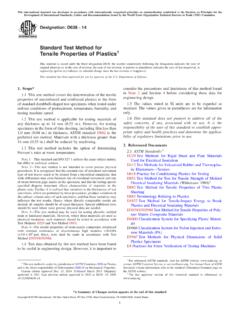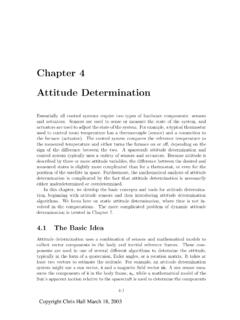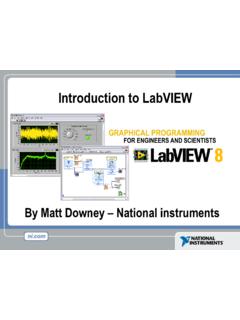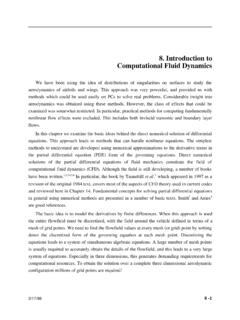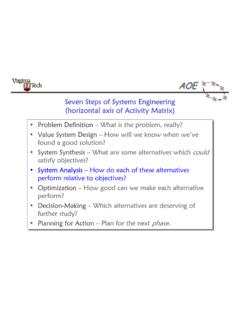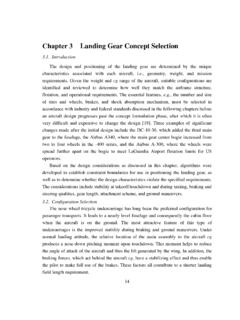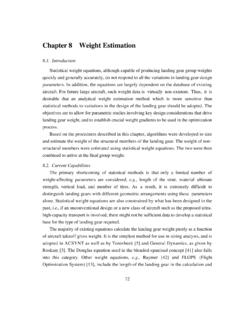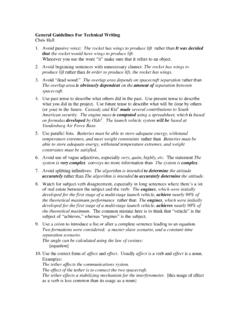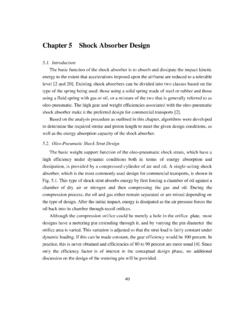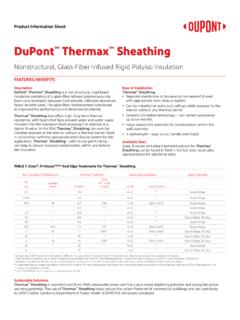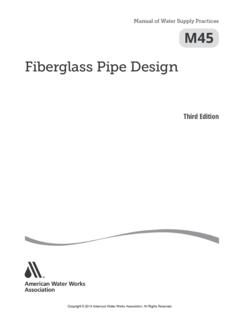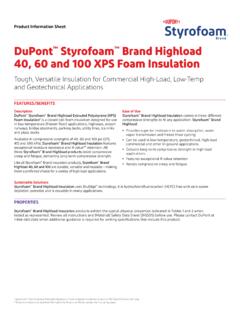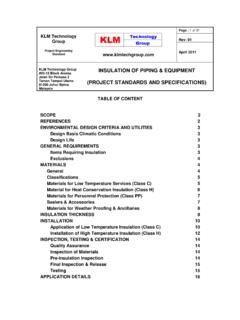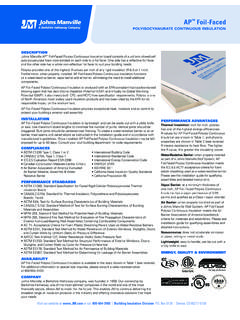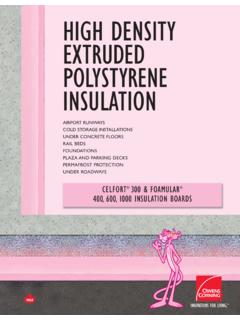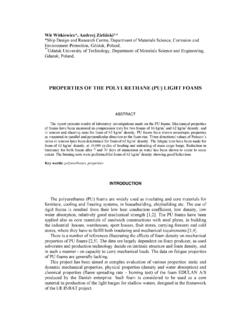Transcription of Standard Test Method for Compressive Properties of Rigid ...
1 Designation: D695 15 Standard Test Method forCompressive Properties of Rigid plastics1 This Standard is issued under the fixed designation D695; the number immediately following the designation indicates the year oforiginal adoption or, in the case of revision, the year of last revision. A number in parentheses indicates the year of last reapproval. Asuperscript epsilon ( ) indicates an editorial change since the last revision or Standard has been approved for use by agencies of the Department of Scope* This test Method covers the determination of the me-chanical Properties of unreinforced and reinforced rigidplastics, including high-modulus composites, when loaded incompression at relatively low uniform rates of straining orloading. Test specimens of Standard shape are employed. Thisprocedure is applicable for a composite modulus up to andincluding 41,370 MPa (6,000,000 psi).
2 The values stated in SI units are to be regarded as thestandard. The values in parentheses are for information For Compressive Properties of resin-matrix composites rein-forced with oriented continuous, discontinuous, or cross-plyreinforcements, tests may be made in accordance with Test MethodD3410/D3410 MorD6641 Standard does not purport to address all of thesafety concerns, if any, associated with its use. It is theresponsibility of the user of this Standard to establish appro-priate safety and health practices and determine the applica-bility of regulatory limitations prior to specific precau-tionary statement is given This Standard is equivalent to ISO Referenced standards :2D618 Practice for Conditioning Plastics for TestingD638 Test Method for Tensile Properties of PlasticsD883 Terminology Relating to PlasticsD3410/D3410 MTest Method for Compressive Properties ofPolymer Matrix Composite Materials with UnsupportedGage Section by Shear LoadingD4000 Classification System for Specifying Plastic Materi-alsD5947 Test methods for Physical Dimensions of SolidPlastics SpecimensD6641/D6641 MTest Method for Compressive Properties ofPolymer Matrix Composite Materials Using a CombinedLoading Compression (CLC) Test FixtureE4 Practices for Force Verification of Testing MachinesE83 Practice for Verification and Classification of Exten-someter SystemsE691 Practice for Conducting an Interlaboratory Study toDetermine the Precision of a Test Standard :3 ISO 604 Plastics Determination of Compressive Properties3.
3 The definitions of plastics used in this testmethod are in accordance with TerminologyD883unlessotherwise deformation the decrease in length pro-duced in the gage length of the test specimen by a compressiveload. It is expressed in units of strain the ratio of Compressive defor-mation to the gage length of the test specimen, that is, thechange in length per unit of original length along the longitu-dinal axis. It is expressed as a dimensionless strength the maximum compressivestress (nominal) carried by a test specimen during a compres-sion test. It may or may not be the Compressive stress(nominal) carried by the specimen at the moment of strength at failure (nominal) the com-pressive stress (nominal) sustained at the moment of failure ofthe test specimen if shattering stress (nominal) the Compressive loadper unit area of minimum original cross section within the gageboundaries, carried by the test specimen at any given is expressed in force per unit The expression of Compressive proper-ties in terms of the minimum original cross section is almost1 This test Method is under the jurisdiction of ASTM CommitteeD20on Plasticsand is the direct responsibility of Mechanical edition approved Sept.
4 1, 2015. Published September 2015. Originallyapproved in 1942. Last previous edition approved in 2010 as D695 - 10. referenced ASTM standards , visit the ASTM website, , orcontact ASTM Customer Service at ForAnnual Book of ASTMS tandardsvolume information, refer to the Standard s Document Summary page onthe ASTM from American National standards Institute (ANSI), 25 W. 43rd St.,4th Floor, New York, NY 10036, *A Summary of Changes section appears at the end of this standardCopyright ASTM International, 100 Barr Harbor Drive, PO Box C700, West Conshohocken, PA 19428-2959. United StatesThis international Standard was developed in accordance with internationally recognized principles on standardization established in the Decision on Principles for theDevelopment of International standards , Guides and Recommendations issued by the World Trade Organization Technical Barriers to Trade (TBT) universally used.
5 Under some circumstances the compressiveproperties have been expressed per unit of prevailing crosssection. These Properties are called true Compressive stress-strain diagram a diagram inwhich values of Compressive stress are plotted as ordinatesagainst corresponding values of Compressive strain as yield point the first point on the stress-strain diagram at which an increase in strain occurs without anincrease in yield strength normally the stress at theyield point (see also ). load the maximum Compressive force ap-plied to the specimen, under the conditions of testing, thatproduces a designated degree of of elasticity the ratio of stress (nominal) tocorresponding strain below the proportional limit of a is expressed in force per unit area based on the average initialcross-sectional Compressive yield strength the stress at whichthe stress-strain curve departs from linearity by a specifiedpercent of deformation (offset).
6 Compressive strain the Compressive defor-mation of a test specimen expressed as a percent of the originalgage limit the greatest stress that a materialis capable of sustaining without any deviation from propor-tionality of stress to strain (Hooke s law). It is expressed inforce per unit ratio the ratio of the length of a columnof uniform cross section to its least radius of gyration. Forspecimens of uniform rectangular cross section, the radius ofgyration is times the smaller cross-sectional specimens of uniform circular cross section, the radius ofgyration is times the diameter. For specimens of tubularcross section, the radius of gyration is calculated as follows:Rg5=D21d24(1)where:Rg= radius of gyration,D= outside diameter, andd= inside Significance and Compression tests provide information about the com-pressive Properties of plastics when employed under conditionsapproximating those under which the tests are Compressive Properties include modulus of elasticity,yield stress, deformation beyond yield point, and compressivestrength (unless the material merely flattens but does notfracture).
7 Materials possessing a low order of ductility may notexhibit a yield point. In the case of a material that fails incompression by a shattering fracture, the Compressive strengthhas a very definite value. In the case of a material that does notfail in compression by a shattering fracture, the compressivestrength is an arbitrary one depending upon the degree ofdistortion that is regarded as indicating complete failure of thematerial. Many plastic materials will continue to deform incompression until a flat disk is produced, the compressivestress (nominal) rising steadily in the process, without anywell-defined fracture occurring. Compressive strength canhave no real meaning in such Compression tests provide a Standard Method of obtain-ing data for research and development, quality control, accep-tance or rejection under specifications, and special tests cannot be considered significant for engineeringdesign in applications differing widely from the load-time scaleof the Standard test.
8 Such applications require additional testssuch as impact, creep, and Before proceeding with this test Method , referenceshould be made to the ASTM specification for the materialbeing tested. Any test specimen preparation, conditioning,dimensions, and testing parameters covered in the materialsspecification shall take precedence over those mentioned in thistest Method . If there is no material specification, then thedefault conditions apply. Table 1 in ClassificationD4000liststhe ASTM materials standards that currently Machine Any suitable testing machine capableof control of constant-rate-of-crosshead movement and com-prising essentially the Mechanism A drive mechanism for impartingto the movable cross-head member, a uniform, controlledvelocity with respect to the base (fixed member), with thisvelocity to be regulated as specified in Indicator A load-indicating mechanism ca-pable of showing the total Compressive load carried by the testspecimen.
9 The mechanism shall be essentially free frominertia-lag at the specified rate of testing and shall indicate theload with an accuracy of61 % of the maximum indicatedvalue of the test (load). The accuracy of the testing machineshall be verified at least once a year in accordance A suitable instrument for determin-ing the distance between two fixed points on the test specimenat any time during the test. It is desirable that this instrumentautomatically record this distance (or any change in it) as afunction of the load on the test specimen. The instrument shallbe essentially free of inertia-lag at the specified rate of loadingand shall conform to the requirements for a Class B-2extensometer as defined in The requirements for extensometers cited herein apply tocompressometers as Tool A compression tool for applying theload to the test specimen. This tool shall be so constructed thatloading is axial within 1:1000 and applied through surfaces thatare flat within mm ( in.)
10 And parallel to each otherin a plane normal to the vertical loading axis. Examples ofsuitable compression tools are shown inFig. 1andFig. 152 Jig A supporting jig for thin specimens isshown inFig. 3andFig. Suitable micrometers, reading to or in. for measuring the width, thickness, diameter,and length of the Test Unless otherwise specified in the materialsspecifications, the specimens described used. These specimens may be prepared by machiningoperations from materials in sheet, plate, rod, tube, or similarform, or they may be prepared by compression or injectionmolding of the material to be tested. All machining operationsshall be done carefully so that smooth surfaces result. Greatcare shall be taken in machining the ends so that smooth, flatparallel surfaces and sharp, clean edges, to within mm( in.) perpendicular to the long axis of the specimen, The Standard test specimen for strength measurements,except as indicated , shall be in the form of a rightcylinder or prism whose length is twice its principal width ordiameter.
